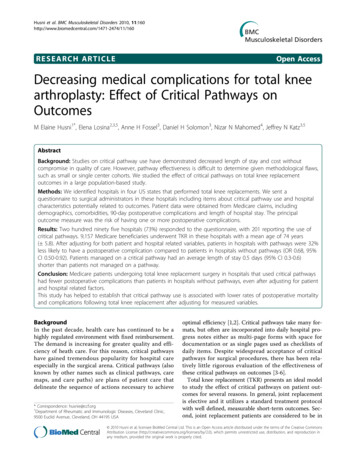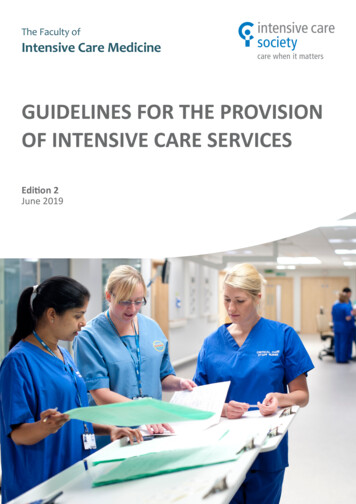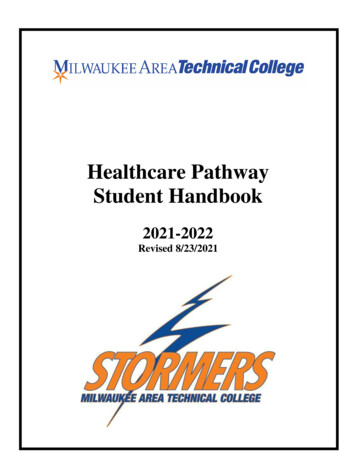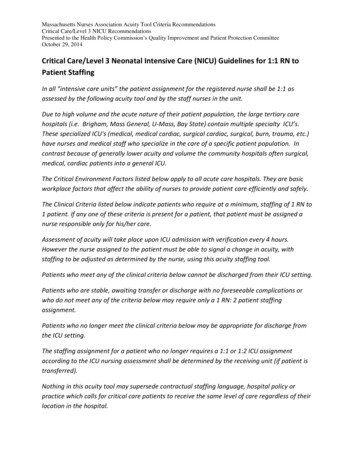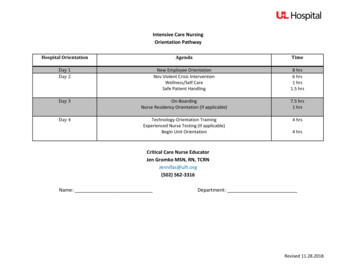
Transcription
Intensive Care NursingOrientation PathwayHospital OrientationAgendaTimeDay 1Day 2New Employee OrientationNov Violent Crisis InterventionWellness/Self CareSafe Patient Handling8 hrs6 hrs1 hrs1.5 hrsDay 3On-BoardingNurse Residency Orientation (If applicable)7.5 hrs1 hrsDay 4Technology Orientation TrainingExperienced Nurse Testing (If applicable)Begin Unit Orientation4 hrs4 hrsCritical Care Nurse EducatorJen Gromko MSN, RN, TCRNJennifas@ulh.org(502) 562-3316Name:Department:Revised 11.28.2018
Unit OrientationYou will meet with your clinical manager who will provide you with a schedule and assign you a preceptor(s). Together you will use the pathwaybelow as a guide during your unit orientation and proof of competency. Upon completion, this pathway will become part of your employee file.Class ScheduleBased on level of experience, you may or may not be enrolled in one of the following classes by your clinical manager and/or unit basededucator. Be sure to check your work email frequently for updates and instructions.1.2.3.ClassCardiac DysrhythmiaBasic Critical Care ClassACLSDatesEvaluation Process (All evaluations will become part of your employee file) You will meet with your preceptor to discuss a personalized orientation plan You are encouraged to complete a weekly orientation evaluation with your preceptor At the completion of weeks 3, 6, 9 and 12, you will be encouraged to complete an Ongoing Orientation Evaluation with your preceptor You will complete a 30, 60, and 90 Day Evaluation with your clinical manager Your completed orientation pathway will be reviewed with your clinical managerSuggested EvaluationsWeekly Orientation Evaluation(Completed and placed in employee file) Week 1 Week 2 Week 4 Week 5 Week 7 Week 8 Week 10 Week 11 Ongoing Orientation Evaluation(Completed and placed in employee file)Week 1-3 Ongoing EvaluationWeek 4-6 Ongoing EvaluationWeek 7-9 Ongoing EvaluationWeek 10-12 Ongoing EvaluationSuggested Systems FocusesThroughout the orientation pathway you will cover multiple body system focuses. These do not have to be completed in order, as long as allsystem objectives are covered within your orientation. System FocusHands on Back to BasicsPulmonaryCardiovascular/Blood DisordersEndocrine Diabetes System ntestinal/RenalOncology/Immunocompromised
ICU Day One Unit Orientation:The following tasks and activities have been completed:The goal of this activity is for the orientee to be able tofunction within the flow of a typical shift, knows who togo to for assistance, where to go for resources, suppliesand equipment necessary to do their work. Objectives: Able to identify unit processes for the normalfunctioning of a shiftAble to locate supplies and resourcesnecessary for normal functioning of a shift ICU Stage 1 - Basic Patient Assessment:The goal of this activity is for the orientee to identifynormal and abnormal findings, recognizes changes incondition, and assimilate this information into thepatient's plan of care, anticipating potentialcomplicationsThe following tasks and activities have been completed: Objectives: Meet and greet with manager and preceptor.Preceptor/orientee interview and discussion of orientation plan andschedule.Unit orientation: Lockers, mailbox, break room, bathrooms, staffing book,paperwork, forms, equipment & supplies, phone system, etc.Ensure access to hospital systems: Email, Scheduling, Pyxis, AutomatedMedication Dispensing System, Access Repository (eForms), PSN,glucometer overview, MyULH, KNOW, etc.Learn processes for nursing functions: patient travel (CT, MRI, etc.),patient transfer, lab drop off, blood bank, pharmacy, etc.Orientation to shift activities: patient assignment, bedside shift report,assessment & documentation requirements (include downtimedocumentation), medication administration.Review Safety CodesReview of assessment elements in LippincottReviews pain and sedation assessments & re-assessments, includinghospital approved pain and sedation scalesObserves and identifies basic critical care patient equipment, its generaluse and maintenance (e.g. TLC, A-line, NG/OGT, DHT, PEG, Chest tube,F/C, ETT, Trach) Online Resource: Lippincott:o Patient AssessmentPolicy: 600-0146 Pain ManagementPolicy: 600-1406 Adult inpatient standards ofcare and documentation attachment tocritical care admission criteria Policy: 600-1319 Clinical AlarmsDemonstrates accurate head to toeassessment, verified by concurrent preceptorassessmentCorrectly documents assessment findings inCerner PowerchartICU Stage 1 - Bedside Monitor and Alarms:The goal of this activity is for the orientee to be able touse monitoring equipment to monitor patient'scondition and recognize trends.The following tasks and activities have been completed: Reviews bedside monitor set up for patient specific monitoringequipment (ABP, ICP, CVP, UAP), changing leads, placing the monitor instandby
Objectives: Able to adjust alarms appropriately based onpatient diagnosis and condition, and recognize andappropriately respond to patient alarmsReviews adjustment of alarms and parameters, various alarm levels andappropriate assessments and interventionsICU Stage 1 - Care Plans:The following tasks and activities have been completed:The goal of this activity is for the orientee to correctlyformulate the plan of care for patients utilizing theprinciples of effective time managementDevelop a age appropriate (adolescent, adult, geriatric) plan of care for the patient.Objectives: Able to utilize the nursing process to identifykey treatment modalities, potentialcomplications and expected outcomesICU Stage 1 - Computer Systems:The following tasks and activities have been completed:The goal of this activity is for the orientee to utilizespatient information from electronic documentation toformulate and modify the patient's plan of careReview of computer systems for the following areas:Objectives: Identifies and locates pertinent patientinformation (radiology reports, laboratorydata, admission information, etc.) in CernerPowerChartICU Stage 1 - Lab Procedures:The goal of this activity is for the orientee to understandthe significance of laboratory results and able toincorporate the data into the patient's plan of careObjectives: Correctly demonstrates obtaining specimensfrom various sources, labels it according to thered rule, and appropriately delivers thespecimen to the lab Online Resource: MyULH - CERNERPOWERCHART Job Aids Policy: 4705-7429 Massive TransfusionProtocol (MTP) - Recumbiant Factor Vlla(r(FVlla) UsePolicy: 600-0306 BloodPolicy: 600-1318 Blood Culture CollectionLab order entry and resultCharting in Cerner PowerChartRadiology and Intra-operative reportsCentral Supply ordering mechanismsThe following tasks and activities have been completed:Reviews lab procedures, including: Red RuleVenipunctureArterial line drawCentral line drawUnable to obtainDowntime proceduresTubing vs. walking lab specimens
Verbalizes conditions requiring laboratorymonitoring and frequency UrineCSFStoolSputumCulturesPOC (Glucometer, iStat)Blood Product AdministrationMassive Transfusion ProtocolICU Stage 1 - Medications:The following tasks and activities have been completed: The goal of this activity is for the orientee to identify thepatient's condition and changes that would necessitatecalling a physician and requesting a new medication,holding a medication or a change of routeReviews process for written orders and telephone orders, scanning orders topharmacy, and appropriate documentation on the MAR and in AutomatedMedication Dispensing System Reviews medication storage, administration and disposal. Reviews and practices administering medications: PO, per tube, IV, Sub-Q, IM,transdermal, PR Objectives: Correctly performs the 7 "Rights" ofmedication administration and administersmedication appropriately. Includes patienteducation. Documents correctly on MAR and inAutomated Medication Dispensing SystemUnderstands common critical care drugs,knows how to locate further information forunfamiliar medicationsAble to verbalize a patient specific reason foreach medicationIdentifies contraindications for eachmedication administeredUnderstands common critical care drugs,knows how to locate further information forunfamiliar medicationsAble to verbalize a patient specific reason foreach medicationIdentifies contraindications for eachmedication administeredCorrectly performs the 7 "Rights" ofmedication administration and administersmedication appropriately. Includes patienteducation.Reviews IV Medication Administration Policy and Critical Care Drip Quick ReferenceReviews High Alert Medication Policy and principles of an independent doublecheckPolicy: 5100-0333 IV MedicationAdministrationPolicy: 600-0146 Pain ManagementPolicy: 600-0148 Epidural Analgesia Administration and MonitoringOnline Resource: Sigma Pump OperatorsManualOnline Resource: LexicompResource Binder: Critical Care IV Drip QuickReference
Documents correctly on MAR and inAutomated Medication Dispensing SystemUnderstands common critical care drugs,knows how to locate further information forunfamiliar medicationsAble to verbalize a patient specific reason foreach medicationIdentifies contraindications for eachmedication administeredICU Stage 1 - Patient and Family Centered Care:The following tasks and activities have been completed:The goal of this activity is for the orientee to recognizethe importance of family and how each PFCC initiativeimpacts the patient's overall health and well-beingReviews unit policies regarding Patient- and Family-Centered Care initiatives:Objectives: Embraces the concept of PFCC and applies itstenets into their daily practice Collaboration & ParticipationInformation SharingDignity & RespectFamily presence policyBedside shift reportHourly roundingPartners in CareCode words and aliasesDaily Goals & WhiteboardICU Stage 1 - Quality and Safety:The following tasks and activities have been completed:The goal of this activity is for the orientee to identify andimplement strategies to maintain patient safety. Theorientee will also understand and actively participate inall quality and safety goals of the unit and facilityReviews policies and procedures regarding quality metrics:Objectives: Applies all infection prevention bundlestrategies in daily care of all patientsIdentifies appropriate indications for restraintuse, and monitors patient for complicationsand potential removalICU Stage 2 - Admission, Transfers, & Discharges: VAECAUTICLA-BSIPressure UlcersFallsRestraintsIsolation ProtocolsThe following tasks and activities have been completed: Policy: 600P-0376 VAE-VAP PreventionPolicy: 600-1355 Prevention of CLABSIPolicy: 600-1350 Prevention of CAUTIPolicy: 600P-1316 Indwelling Urinary Catheterand Catheter Associated Urinary TractInfection (CAUTI) Prevention ProtocolPolicy: 600-0368 Restraints and SeclusionPolicy: 600-0807 Falls Prevention ProgramInpatientPolicy: 600-0304 Critical Care AdmissionCriteria
The goal of this activity is for the orientee to be able toperform an admission independently, review andcomplete all orders, and formulate a proper plan of care.The orientee should also be able to collaborate with thepatient’s primary team, and all consulting services toprovide optimal care. The orientee will be able toindependently transfer a patient to another unit as wellas independently discharge a patientObjectives: Demonstrates gathering supplies and settingup equipment for a new patient admission.Prepares appropriate paperwork anddocumentation for patient admission.Demonstrates performing an in-depthadmission assessment, patient history andother documentation requirements.Identifies differences between admitting a newpatient and internal transfer.Identifies differences between downgradesand discharges to home or other facility.Reviews admission of new patient to central monitors Reviews room set up and supply preparation Reviews admission history adhoc formReviews admission documentation requirements, including:Admission Assessment Past Medical History & Transfer PaperworkMedication ReconciliationReviews the transfer process, including: ICU, Med/Surg & PCU Admission Criteria PoliciesTransfer DocumentationTransfer to other FacilityDischarge Planning & DocumentationAMA Discharge PolicyICU Stage 2 - Basic and Intermediate Hemodynamics:The following tasks and activities have been completed: The goal of this activity is for the orientee to be able toutilize data retrieved from patient monitoring to assess& track patient condition. The orientee will alsoformulate treatment, assess response to treatment andmodify the plan for care.Reviews principles and processes of setting up, assisting with insertion andmonitoring: Objectives: Identifies appropriate monitoring devicesbased on patient condition.Able to set up lines for insertion, correctlymaintain and identify criteria for removal.Correctly interprets monitoring data related tothe patient’s condition, and formulatestreatment modalitiesPolicy: 600-0303 PCU Admission DischargeCriteriaPolicy: 600-0302 Medical Surgical AdmissionDischarge CriteriaPolicy: 4400-0000 Admission, Transfer,Discharge of Patients from Operating RoomPolicy: 600-0204 In-house Patient TransfersUnit Resource: AACN Procedure Manual forHigh Acuity, Progressive, and Critical Care Arterial LinesCentral Venous CatheterCentral Venous PressureDialysis CathetersCordisReviews concepts of hemodynamics, including: Fluid resuscitation & balance Blood pressure optimization Resource Binder: Critical Care IV Drip QuickReferencePolicy: 5100-0333 IV MedicationAdministrationOnline Resource: LippincottUnit Resource: AACN Procedure Manual forHigh Acuity, Progressive, and Critical Care
ICU Stage 2 - Cardiac:The following tasks and activities have been completed:The goal of this activity is for the orientee to be able tosynthesize knowledge regarding the cardiac system intocaring for the patient holistically. The orientee willunderstand how cardiac changes interact with othersystems and correctly formulate a care plan.Reviews aspects of in-depth cardiac assessment, including:Objectives: Incorporates assessment findings, identifiesand correctly addresses changes in cardiaccondition.Understands pathophysiology of differentcardiac disease processes, and variables intreatment modalities.Verbalizes purpose for cardiac medication andidentifies contraindications and interactionswith other medications prior to administration.Interprets ECG monitoring strips, identifiesdysrhythmias and formulates treatmentmodalities.Verbalizes equipment and personnel neededto travel with a patient on a cardiac monitor. Online Resource: LippincottOnline Resource: Lexicomp Unit Resource: AACN Procedure Manual forHigh Acuity, Progressive, and Critical CareAuscultationCardiac rhythmsSkin Color, EdemaPulses & Cap RefillVitalsReviews cardiac documentation standardsReviews principles, care modalities, additional assessments, common complicationsand treatment strategies related to cardiac disorders: Dysrhythmiaso Pacemakerso 12 Lead ECGAcute Myocardial Infarctiono Cardiac Enzymeso Affected region & potential effectso Cardiac Cath Procedures (Pre-& Post)Cardiac TamponadePericardiocentesis & Pericardial windowHeart Failureo Systolic & Diastolic dysfunctiono Left versus Right2D Echo and TEEICU Stage 2 - Endocrine:The following tasks and activities have been completed:The goal of this activity is for the orientee to be able tosynthesize knowledge regarding the endocrine systeminto caring for the patient holistically. The orientee willunderstand how endocrine changes interact with othersystems and correctly formulate a care plan. Able tomanage a patient on an insulin drip and properlycalculate titration.Reviews principles, care modalities, additional assessments, common complicationsand treatment strategies related to endocrine disorders:Objectives: Diabetic KetoacidosisNon-Diabetic HyperglycemiaSIADHPancreatic Cancer (Whipple)Adrenal StormReviews the following:
Identifies labs monitoring the endocrinesystem, common complications and identifiestreatment modalities.Able to initiate and maintain insulin drip.Able to correctly intervene for a patient withhypoglycemia. Sliding Scale Insulin ProtocolInsulin Drip Order SetHypoglycemia ProtocolICU Stage 2 - Gastrointestinal:The following tasks and activities have been completed: The goal of this activity is for the orientee to be able tosynthesize knowledge regarding the GI system intocaring for the patient holistically. The orientee willunderstand how GI changes interact with other systemsand correctly formulate a care plan.Reviews aspects of in-depth GI assessments, including: Objectives: Incorporates assessment findings, identifiesand correctly addresses changes in GIcondition.Recognizes importance of early nutritionalsupplementation and identifies patients'unique nutritional needs and advocates forappropriate interventionIdentifies labs monitoring liver failure,common complications and identifiestreatment modalities.Identifies labs monitoring pancreatitis,common complications, treatment modalitiesand dietary considerations.Identifies labs monitoring GI bleed, commoncomplications and identifies treatmentmodalities.Identifies conditions requiring bladderpressure monitoring, significance andtreatment modalities.Demonstrates administration of PO & IVcontrast and communicates with radiology AuscultationPalpationNG / OG / DHT/ PEG / G-tube / J-tubeLaboratory & RadiologyBowel Regimen & Ostomy careReviews GI documentation standardsReviews principles of optimization of nutrition, including enteral & parenteralnutritionReviews principles, care modalities, additional assessments, common complicationsand treatment strategies related to GI/GU disorders: Liver FailureHepatitiso Coagulopathieso Medication clearanceo Hepatic encephalopathyPancreatitisGI Bleedo Upper vs. Lowero EGD / Colonoscopyo Protonix & OctreotideIleus / Obstructiono Bowel Regimens & Enemaso TPN / Lipidso Disimpactiono Ileostomy & Colostomy Online Resource: AbViser Quick ReferenceGuideOnline Resource: LippincottPolicy: 5100-0940-10 Multi-Disciplinary AdultTPN Assessment-Administration andMonitoringPolicy: 3- Enteral Feeding (801-0004)Unit Resource: AACN Procedure Manual forHigh Acuity, Progressive, and Critical Care
regarding timing of tests. Travels withappropriate personnel and equipment. Ischemic / Perforated BowelExploratory LaparotomyAbdominal Compartment Syndromeo Bladder PressureOpen Abdomeno Drains / Suctiono Peritoneal Dialysate Irrigationo Splintingo Dressing / VACICU Stage 2 - Genitourinary:The following tasks and activities have been completed: The goal of this activity is for the orientee to be able tosynthesize knowledge regarding the GU system intocaring for the patient holistically. The orientee willunderstand how GU changes interact with other systemsand correctly formulate a care plan.Reviews aspects of in-depth GU assessments and monitoring, including: Urine & Foley Objectives: Incorporates assessment findings, identifiesand correctly addresses changes in GUconditionIdentifies labs monitoring renal failure,common complications and identifiestreatment modalitiesReviews all GU documentation standardsUnit Resource: AACN Procedure Manual forHigh Acuity, Progressive, and Critical CareOnline Resource: LippincottPolicy: 600P-1322 Nurse Driven UrinaryCatheter Removal ProtocolReviews principles, care modalities, additional assessments, common complicationsand treatment strategies related to GU disorders: Renal Failureo Acute vs. Chronico Pre-, Intra- & Posto Electrolyte imbalanceso Medication Clearanceo Dialysiso Rhabdomyolysis Urostomy Bladder Irrigation & Titration Bladder Rupture & Urethral TearsICU Stage 2 - Immunology:The following tasks and activities have been completed: The goal of this activity is for the orientee to be able tosynthesize knowledge regarding auto-immune disordersinto caring for the patient holistically. The orientee willunderstand how auto-immune disorders interact withother systems and correctly formulate a care plan. Ableto manage a patient on an insulin drip and properlycalculate titration.Reviews principles, care modalities, additional assessments, common complicationsand treatment strategies related to auto-immune disorders: Myasthenia Gravis Graves Disease Gullian-Barre ALS HIV / AIDS Unit Resource: AACN Procedure Manual forHigh Acuity, Progressive, and Critical CareOnline Resource: Lippincott
Objectives: Identifies labs monitoring the specific autoimmune disorder, common complications andidentifies treatment modalities.ICU Stage 2 - Integumentary:The following tasks and activities have been completed: The goal of this activity is for the orientee to be able tosynthesize knowledge regarding the integumentarysystem into caring for the patient holistically. Theorientee will understand how integumentary changesinteract with other systems and correctly formulate acare plan. Provide patient with psychosocial supportregarding alterations in body image.Reviews aspects of in-depth integumentary assessments, including: Braden Scale Wound Assessment & Staging Edema Surgical Site Flap Care Objectives: Incorporates assessment findings, identifiesand correctly addresses changes inintegumentary condition.Able to assess flaps for adequate circulationand identify signs and symptoms of a failinggraft site.Reviews integumentary documentation standardsReviews principles, care modalities, additional assessments, common complicationsand treatment strategies related to integumentary disorders: Specialty Beds DressingsICU Stage 2 - Musculoskeletal:The following tasks and activities have been completed: The goal of this activity is for the orientee to be able tosynthesize knowledge regarding the musculoskeletalsystem into caring for the patient holistically. Theorientee will understand how musculoskeletal changesinteract with other systems and correctly formulate acare plan.Reviews aspects of in-depth musculoskeletal assessments, including: Sensory Motor (Gross & Fine) Fracture Sites Objectives:Reviews principles, care modalities, additional assessments, common complicationsand treatment strategies related to musculoskeletal disorders: Fractureso Traction (Bucks, Skeletal)o External Fixators & Pin Careo Compartment Syndrome Range of Motion (Passive & Active) Soft Tissue Damage Incorporates assessment findings, identifiesand correctly addresses changes inmusculoskeletal conditionMaintains fracture sites in-line, correctlysplints and supports during patient careUnit Resource: AACN Procedure Manual forHigh Acuity, Progressive, and Critical CareOnline Resource: LippincottReviews musculoskeletal documentation standardsUnit Resource: AACN Procedure Manual forHigh Acuity, Progressive, and Critical CareOnline Resource: Lippincott
OsteomyelitisICU Stage 2 - Neurological:The following tasks and activities have been completed: The goal of this activity is for the orientee to be able tosynthesize knowledge regarding the neurological systeminto caring for the patient holistically. The orientee willunderstand how neurological changes interact withother systems and correctly formulate a care planReviews aspects of in-depth neuro exam, including: Objectives:Review all neuro documentation standards Incorporates assessment findings andidentifies neurological changes, and formulatesappropriate treatment modalitiesPredicts and manages common neurologicalcomplications / side effects, such as autonomicdysregulation, temperature management &agitationVerbalizes the principles of neurologicalperfusion optimization, including CPP, HHHtherapy, hypertonic saline & mannitolIdentifies important assessment findings in thespinal cord patient, maintains spinal alignment,predicts complications, such as respiratorycompromise, neurogenic bladder, andformulates plan of careVerbalizes personnel and equipment necessaryto travel with a neuro or spinal cord injurypatient to CT, MRI, etc. GCSooPupillary responses (pupilometer, if applicable)Motor and sensory function/responsesReviews principles, care modalities, additional assessments, common complicationsand treatment strategies related to neurological disorders: TBIo SDH, SAH, ICH, IPH, DAIo Blood Pressure Managemento Seizure Prophylaxiso Autonomic Dysregulationo Diabetes InsipidusStrokeo Ischemic: tPA, thrombectomy, angioplastyo Hemorrhagic: coiling, clippingo Blood Pressure Managemento NIH Stroke ScaleCraniotomy vs. Craniectomyo Hematoma Evacuationo Bone flapIncreased ICP & EVDo Signs/Symptomso ICP Management Conceptso Insertion & Maintenance of EVDo Refer to EVD Clinical GuidelinesNeurogenic ShockSpinal Cord Injuryo Level effectedo Sensory / Motor Losso Cervical Traction / Haloo TLSO & Somi Extension Policy: 600-0112 Brain Death DefinitionDeterminationPolicy: 600-0112A Brain Death TestingProtocolPolicy: 600-0126 Organ Donation - BrainDeathPolicy: 600-0126A Declaration of Brain DeathAttestationPolicy: 600P-1317 Bispectral Index (BIS)MonitoringPolicy: 600P-1330 Stroke Alert ProtocolInpatientPolicy: 5100-0929 Pharmacological BurstSuppression TherapyUnit Resource: AACN Procedure Manual forHigh Acuity, Progressive, and Critical Care(7th ed.) (some suggested topics):o Pupillometero EVDo Neuromuscular BlockadeOnline Resource: Lippincott (some suggestedtopics):o ETCO2o Warming Blanket Useo Hyperthermia-hypothermia blanketuseo EVDOnline Resource: MyULH ComprehensiveStroke Center Educational Resources andToolsResource Binder: Bactiseal and AccuDrainQuick Reference
Status Epilepticuso Continuous EEGo Burst SuppressionICU Stage 2 - Palliative and End of Life Care:The following tasks and activities have been completed: The goal of this activity is for the orientee to be able toadvocates for the use of the palliative team forappropriate patients. The orientee will also collaboratewith the patient care team to provide holistic end of lifecare to the patient and family.Reviews concepts of end of life care, including: Palliative Care Team Palliative Care Order Set DNAR Withdraw of Care KODAo Brain Deatho Donation after Cardiac Deatho Tissue Procurement Hospice ICU Stage 2 - Pharmacology:The following tasks and activities have been completed: The goal of this activity is for the orientee to be able toutilize correct advanced pharmacological agents tomaintain hemodynamic stability. The orientee will alsoutilizes RASS, the appropriate pain scale, TOF and BIS toguide sedation pain medication, and neuromuscularblockade administration. The orientee will be able tomanage a patient on a continuous anti-coagulationinfusion and correctly assimilate laboratory data andcalculate drip changes.Reviews principles of hemodynamics in relation to vasoactive drips,antiarrhythmics, & ACLS, including: Objectives:Reviews principles of agitation, sedation and pain management, including:Objectives: Identifies appropriate patients for palliativecare.Verbalizes key concepts of care to the end oflife patient.Identifies difference between caring for DNARand “comfort measures.”Consults KODA appropriately.Verbalizes the purpose of different advancedpharmacological agents.Understands side effects and contraindicationsfor the use of advanced pharmacological drips. Vasopressors & VasodilatorsABXInotropesChronotropesCalcium Channel BlockersBeta BlockersPRN, PCA’s & Continuous DripsPrinciples of SedationAppropriate Pain ManagementCIWA Scale Policy: 600-0129 Organ Donation - Donationafter Circulatory DeathPolicy: 600-0126 Organ Donation - BrainDeathPolicy: 600-0131 Do Not AttemptResuscitation Order (DNAR-DNR)Policy: 600-0146 Pain ManagementPolicy: 600-0112 Brain Death DefinitionDeterminationResource Binder: IV Drip Mixing QuickReference GuidePolicy: 5100-0333 IV MedicationAdministrationPolicy: 600-0146 Pain ManagementPolicy: 600P-1317 Bispectral Index (BIS)MonitoringPolicy: 600-0148 Epidural Analgesia Administration and MonitoringOnline Resource: Lippincott (some suggestedtopics:o Neuromuscular BlockadeOnline Resource: LexicompResource Binder: Critical Care IV Drip QuickReference
Understands which pain and sedation scalesare appropriate for use.Recognizes appropriate orders for pain andsedation medication.Verbalizes indications for continuousneuromuscular blockade.Able to perform TOF & BIS.Verbalizes the indications for prophylactic andtherapeutic anticoagulation. Neuromuscular Blockade (Infusion & Intermittent)Reviews principles of anticoagulation, including: Prophylactic vs. TherapeuticOralSubcutaneousIV DripICU Stage 2 - Pre- & Post-Operative:The following tasks and activities have been completed: The goal of this activity is for the orientee to be able toindependently prepare a patient for surgery. Theorientee will also be able to independently recover apost-operative patient including predicting andformulating interventions for potential complicationsReviews pre-operative procedures, including: Pre-Op ChecklistPre-Op Orders (Labs, Medications, Blood Products)Medication Bubble SheetTransport requirements Objectives: Reviews post-operative procedures, includingDemonstrates ability to prepare and transporta patient to the operating room.Demonstrates ability to correctly recover animmediate post-operative patient.Identifies required elements of post-operativeorders.Identifies potential post-operativecomplications. Recovery assessmentRecover documentation requirementsSigns & symptoms of anesthesia reaction Review of appropriate post-operative ordersICU Stage 2 - Procedures & Procedural Sedation:The following tasks and activities have been completed: The goal of this activity is for the orientee to be able toindependently assists with a procedure, administerprocedural sedation, monitor patient intra- and postprocedure and documents app
Intensive Care Nursing Orientation Pathway Hospital Orientation Agenda Time Day 1 New Employee Orientation 8 hrs Day 2 Nov Violent Crisis Intervention Wellness/Self Care . Observes and identifies basic critical care patient equipment, its general use and maintenance (e.g. TLC, A-line, NG/OGT, DHT, PEG, Chest tube, .



